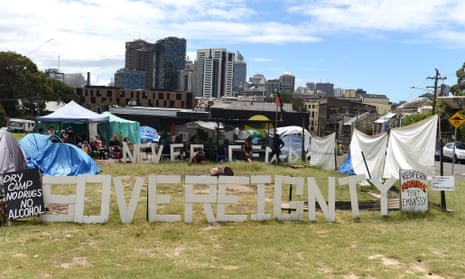The acrimonious fight between the Aboriginal Housing Company seeking to redevelop the Block in Redfern and the community protestors who have erected a tent embassy to protest reveals deep divisions in the Redfern community.
I’ve known Mick Mundine, the CEO of the Aboriginal Housing Company, and Jenny Munro, a leader of the protest campaign, since I was a teenager. Over the decades I’ve seen them both, in their very different ways, show unrelenting passion for what is best for Redfern.
Their conflict arises from their very different views about how to achieve the best outcomes. The Aboriginal housing company has been committed to a redevelopment of the Block, but has failed to get the financial backing for the Aboriginal social housing component; the protestors see the development as transforming the fundamental nature of the community in Redfern.
The fracture seems reflective of so many divisions in Indigenous politics, from opinions about constitutional recognition, to disagreements about the nature of welfare reform. While almost everyone can agree on the problems, the solutions cause deep ruptures.
Like most politics that aim at a reform agenda, there are different views about strategy. The Aboriginal community has a strong history of resistance: from the early days of the colony with leaders like Pemulwuy and Yagan, to the Coranderrk petitions, the Australian Aboriginal Progressive Association’s defiance of the NSW Aborigines Protection Board, to the day of mourning protests in 1938, the Pilbara strike and the Wave Hill walk off, to the Aboriginal Tent Embassy and the anti-Bicentennial march in 1988.
There is a rich history of marching in the streets, protesting through boycott and keeping a visible, challenging and confrontational presence.
It’s not surprising then that there remains a strong commitment to challenge the system today – to question its legitimacy and authority from the outside, to highlight where it is unfair, inequitable, hypocritical and blatantly racist.
The other approach is to work within the system – to join the professions and participate in party politics – to seek to make change. This was not an option for Indigenous people in previous generations, when segregation was rife and discrimination entrenched.
The waves of protest movements brought down barriers, opened doors and meant Aboriginal and Torres Strait Islander people could take up roles and positions that their parents and grandparents never dared dreamed of.
The increasing challenge has been to determine how Aboriginal and Torres Strait Islander people can effectively change the system from within once they step into positions of power. Protest only achieves so much and it is easy to offer criticism from the outside. Getting a seat at the table doesn’t often garner results either.
The existence of an Indigenous Advisory Council to the Australian government hasn’t stopped funding cuts to frontline services or prevented the prime minister from making embarrassing gaffes, such as referring to living in remote communities as “lifestyle choices”. Nor has it stopped or ameliorated the debacle around the Indigenous Advancement Strategy Funding that seems to have defunded or underfunded many community-controlled organisations.
There’s no proof that a culture shift comes naturally with more representation. It certainly hasn’t followed for women generally, especially not in boardrooms, courts and politics.
Within the criminal justice system, the response to the continual increase in the number of Indigenous people in custody has included strategies to include more Indigenous people in the court process – as Aboriginal community liaison officers in the police force, or as bail and court officers in the courts.
As has been proven to date, while having more Indigenous employees can assist on a micro level, at the macro level there has been little shift. “Tough on crime” policies that penalise the poor, like imprisonment for fine default, still remain in place. Approaches that punish the homeless, like a presumption against bail if you have no fixed address, are unlikely to be wound back soon and fall disproportionately on Indigenous Australians. The increase in the workforce makes very little change to culture or policy, and Aboriginal people remain overrepresented in jail.
There is an exception to this. The Australian Indigenous doctors’ association has worked to increase the number of Indigenous people studying medicine and has made important interventions in the area of health policy. One of its most important achievements has been to work with the Council of Australian Medical Deans to ensure that all graduates from Australian medical schools are competent to treat Indigenous clients.
The full effects of this fundamental change will not be fully felt for years. It is nonetheless a reminder that walking through the doors opened by previous generations is not enough on its own – there needs to be concerted effort and partnerships to ensure that change follows. Not everyone who has had the benefit of increased access feels the obligation to work for change for others.
The other consequence of the increase in participation in professional and political life has been the elevation in socio-economic position of Indigenous people and their families, who have been able to access education, enter the workforce and find well-paid employment.
This achievement, in the development of an emerging Indigenous middle class, comes with its own set of challenges. How does a community that has partly been defined by its exclusion, disadvantage and poverty redefine itself? How does it increase its participation in the mainstream and not be assimilated?
There are elements of the broader Australian community who seem affronted that Indigenous people can embrace the advantages of education and employment but refuse to leave their Aboriginal and Torres Strait Islander identity at the door. But the important and critical questions about this gradual transition into the mainstream are mostly for the Indigenous community.
When I studied at Harvard Law School in the 1990s, few of my African American classmates were from poor backgrounds; they were quick to tell you they were from wealthy families, that their parents had “made it”. Yet if you walked from the law school to Harvard Square, almost everyone who was begging on the street was African American.
African Americans are statistically more likely to live in poverty and to end up in jail. The African American success story has since expanded to include Barack Obama, African Americans on the supreme court, in every elite college and university, and in every corridor of power. Conservative African Americans seem to have an attitude that others should “just get on with it”, to work as though the system they have so successfully navigated doesn’t have a negative effect against anyone at all.
To me, that always seemed like its own kind of denial.
But it shows the challenges the Australian Indigenous community will face as our our own middle class starts to emerge. There will be those who resent the economic mobility of some in their community – if you’re not from the “mish”, you don’t know what being Aboriginal is about. There will be others who fail to see how hard it is for people who aren’t able to break the cycle of disadvantage. And there’ll be people who have little sympathy for those who don’t “pull themselves up by their bootstraps” or “get off the grog”, as though it’s as easy as that in every situation.
A person’s cultural identity is not defined by their poverty; you are not more Aboriginal if you grew up struggling. At the same time, the history of our own community – and the marginalisation that is the reality for many Aboriginal and Torres Strait Islander people – will always be relevant to those who have become the new Indigenous middle class. Protest and fighting for inclusion into mainstream society should be at the forefront of a contemporary Indigenous worldview.
One thing that always struck me was that most of that generation who were so active in Redfern when I was growing up – Millie Ingram, Naomi Meyers, Bronwyn Penrith, Sol and Bob Bellear, Gary Foley, the Mundines, the Coes and the Munros – all seemed to be fighting for changes that were going to benefit their children, not themselves.
Even though they were part of the protests in the street, many of them would lead Aboriginal community organisations – from the Aboriginal medical service to the women’s centre, the child care centre and the aged care organisation – that challenged the mainstream delivery of services.
“We didn’t protest at the tent embassy so you could still be protesting outside,” Roberta Sykes once said to me. Nor did it seem that the goal to gain greater access to education, health, employment existed so that we could be assimilated, that we would forget the struggle, forget our history, forget our culture.

